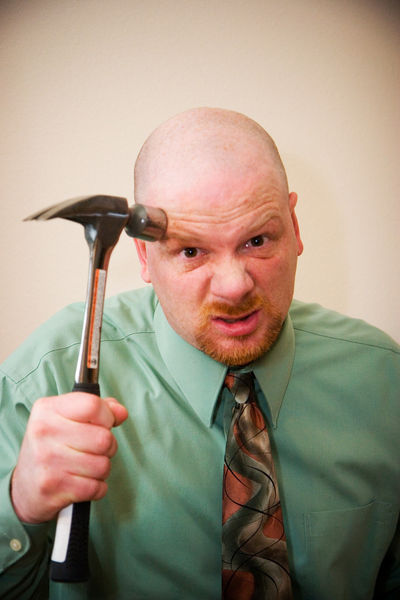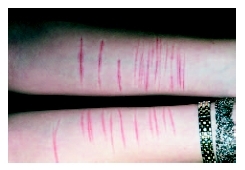Self-mutilation

Definition
Self-mutilation, also called self-harm, self-injury or cutting, is the intentional destruction of tissue or alteration of the body done without the conscious wish to commit suicide , usually in an attempt to relieve tension.
Description
Self-mutilation has become an increasing problem among adolescents since the 1990s. Cutting one's skin with razors or knives is the most common pattern of self-mutilation. Other forms of self-harm include biting, hitting, or bruising oneself; picking or pulling at skin or hair; burning oneself with cigarettes, or amputating parts of the body. Self-mutilation can be episodic (infrequent) or repetitive. Episodic self-harm can progress to repetitive self-harm after as few as five or as many as 20 episodes.
Professional thinking about self-mutilation has evolved over the past 20 years. Before the 1990s, self-mutilation was often identified as a failed suicide attempt. This concept is no longer accepted. As of 2004 self-mutilation was not a specific diagnosis recognized by the American Psychiatric Association. Instead, it is recognized as a feature of other psychiatric disorders. Some researchers dispute this designation and feel self-mutilation should be a separate diagnosis. Self-mutilation should not be confused with current fads for tattoos and body piercing . In some cases, however, it may be difficult to distinguish between an interest in these fads and the first indications of a disorder.
Demographics
It is estimated that one in every 100 individuals in the United States, or more than 2.5 million people, are self-mutilators. Girls are four times more likely to engage in self-harm than boys, with girls between the ages of 16 and 25 at highest risk, although many girls begin cutting in middle school (ages 12 or 13). At risk individuals also include those who have underlying psychiatric disorders. Up to half of individuals who are self-mutilators were sexually abused as children.
Causes and symptoms
It is not entirely clear why some individuals mutilate themselves. However, self-injury appears to give these people an immediate release from almost unbearable tension caused by anxiety , anger, or sadness. Some researchers ascribe this response to the release of certain chemicals in the body in response to pain . Like other addictive behaviors, self-mutilation gradually takes more and more destruction to achieve release. Some researchers separate self-mutilators into several groups, based on their psychological condition, motivation for harming themselves, and degree to which they practice self-injury.
The most common form of self-mutilation, and the one usually seen in adolescents, is impulsive self-mutilation consisting of superficial skin cutting and burning. Psychiatrists generally believe that this is a maladaptive form of self-help or self-preservation and is done to achieve release from almost unbearable psychic tension and to give the individual a feeling of control. It is often a feature of psychiatric disorders including the following:
- borderline personality disorder
- antisocial personality disorder
- dissociative disorders
- anorexia or bulimia
- post traumatic stress syndrome
- substance abuse
- depression
Compulsive self-mutilation consists of repetitive hair pulling ( trichotillomania ), nail biting, and skin picking. It is often found in individuals with obsessive-compulsive disorder (OCD). Major self-mutilation is the least frequent form of self-harm. It involves infrequent episodes of destruction of large amounts of tissue, for example self-castration or self-amputation. Major self-mutilation occurs most often with psychotic or highly intoxicated individuals and occasionally with institutionalized mentally retarded individuals. It is also occasionally associated with autism , Tourette syndrome , and schizophrenia .
The symptoms of self-mutilation typically include wearing long-sleeved or baggy clothing, even in hot weather, and an unusual need for privacy. Self-mutilators are often hesitant to change their clothes or undress around others. In most cases the individual also shows signs of depression.
When to call the doctor
Parents and caregivers should consult a psychiatrist or psychotherapist with professional expertise in self-mutilation as soon as the behavior is discovered. Adolescents rarely do not outgrow this behavior. If left untreated, it can continue into adulthood.
Diagnosis
Self-mutilation is usually diagnosed by a psychiatrist or psychotherapist upon referral from a family member, physician, nurse, or social worker who has noticed scars, bruises , or other physical evidence of self-injury.
Treatment
Individuals who mutilate themselves should seek treatment from a therapist with some specialized training and experience with this behavior. Most self-mutilators are treated as outpatients, although some specialized inpatient programs for self-mutilators exist. A number of different treatment approaches are used with self-mutilators, including individual therapy, family therapy , and group therapy. Therapies focus on teaching self-awareness, alternate coping skills, behavior modification, and improved communication skills . Techniques may

Underlying psychological disorders are also treated with medication and/or psychotherapy. Although there are no medications specifically for self-mutilation, antidepressants are often given, particularly if the patient meets the diagnostic criteria for a depressive disorder. However, in October 2003, the United States Food and Drug Administration issued an advisory indicating that children being treated with selective serotonin re-uptake inhibitor antidepressants (SSRIs) for major depressive illness may be at higher risk for committing suicide. A similar warning was issued in the United Kingdom. Parents and physicians must weigh the benefits and risks of prescribing these medications for children on an individual basis.
Alternative treatment
Mindfulness training, which is a form of meditation, has been used to teach self-mutilators to observe and identify their feelings in order to have some control over them.
Prognosis
The prognosis depends on the presence and severity of other emotional disorders and history of sexual abuse and/or suicide attempts. In general, teenagers without a history of abuse or other disorders have a good prognosis. Patients diagnosed with borderline personality disorder and/or a history of attempted suicide are considered to have the worst prognosis.
Prevention
Some society-wide factors that influence self-mutilation, such as the sexual abuse of children and media portrayals of cutting, are difficult to change. Parents should emphasize self-respect and respect for one's body. In general, young people who have learned to express themselves in words or through art and other creative activities are less likely to deal with painful feelings by injuring their bodies.
Parental concerns
Parents should be alert to Internet sites and movies that promote and/or glorify self-mutilation as a way to cope with problems. Experts feel that some children may be induced to try this behavior as a coping mechanism because of the way it is presented in these media.
KEY TERMS
Borderline personality disorder (BPD) —A pattern of behavior characterized by impulsive acts, intense but chaotic relationships with others, identity problems, and emotional instability.
Dissociative disorders —A group of mental disorders in which dissociation is a prominent symptom. Patients with dissociative disorders have a high rate of self-mutilation.
Selective serotonin reuptake inhibitors (SSRIs) —A class of antidepressants that work by blocking the reabsorption of serotonin in the brain, thus raising the levels of serotonin. SSRIs include fluoxetine (Prozac), sertraline (Zoloft), and paroxetine (Paxil).
See also Depressive disorders .
Resources
BOOKS
Milia, Diana. Self-Mutilation and Art Therapy. Herndon, VA: Kingsley Publishers, 2000.
Strong, Marilee, et al. A Bright Red Scream: Self-Mutilation and the Language of Pain. Collingdale, PA: DIANE Publishing Group, 2001.
Winkler, Kathleen. Cutting and Self-Mutilation: When Teens Injure Themselves. Berkeley Heights, NJ: Enslow Publisher, 2003.
PERIODICALS
"Self-cutting is almost epidemic in adolescents." Pediatric News 36 (September 2002): 29.
"Self-Injury." Brown University Child and Adolescent Behavior Letter –20 (March 2004): 14.
ORGANIZATIONS
American Academy of Child and Adolescent Psychiatry. –3615 Wisconsin Avenue, NW, Washington, DC 200163007. Web site: http://www.aacap.org.
American Psychiatric Association. 1400 K Street, NW, Washington, DC 20005. Web site: http://www.psych.org.
Focus Adolescent Services. Web site: http://www.focusas.com.
Tish Davidson, A.M. Rebecca J. Frey, PhD
I'm nineteen years old and severly depressed.
I've lost interest in everything
I find ways to hurt myself
I cut and I'm seeing a therapist.
I have this sick urge to cut myself.
I can't stop these suicidal thoughts.
I hope I get better.
Somebody help me
I wish I never ever caught
I have scarred my soul
I wish I never gave in
helphelphelp